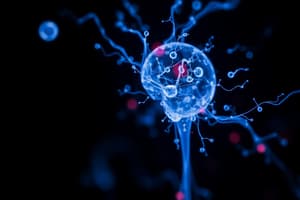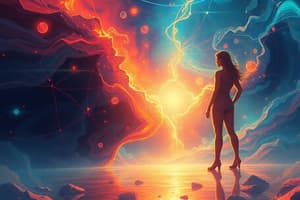Podcast
Questions and Answers
What is sensation?
What is sensation?
Process of detecting a physical stimulus, such as light, sound, heat, or pressure.
What is perception?
What is perception?
The process of integrating, organizing, and interpreting sensations.
What are sensory receptors?
What are sensory receptors?
Specialized cells unique to each sense organ that respond to a particular form of sensory stimulation.
What is transduction?
What is transduction?
What is absolute threshold?
What is absolute threshold?
What is the difference threshold (just noticeable difference)?
What is the difference threshold (just noticeable difference)?
What does Weber's law state?
What does Weber's law state?
What is sensory adaptation?
What is sensory adaptation?
What is subliminal perception?
What is subliminal perception?
What does wavelength refer to?
What does wavelength refer to?
What is the cornea?
What is the cornea?
What is the function of the pupil?
What is the function of the pupil?
What is the iris?
What is the iris?
What is the fovea?
What is the fovea?
What is the retina?
What is the retina?
What is the optic disk?
What is the optic disk?
What is the lens?
What is the lens?
What are optic nerve fibers?
What are optic nerve fibers?
What is iridology?
What is iridology?
What is accommodation?
What is accommodation?
What are rods?
What are rods?
What is the blind spot?
What is the blind spot?
What are ganglion cells?
What are ganglion cells?
What are bipolar cells?
What are bipolar cells?
What is the optic chiasm?
What is the optic chiasm?
What is color?
What is color?
What does hue refer to?
What does hue refer to?
What is saturation?
What is saturation?
What is brightness?
What is brightness?
What is the trichromatic theory of color vision?
What is the trichromatic theory of color vision?
What is color blindness?
What is color blindness?
What is an afterimage?
What is an afterimage?
What is the opponent-process theory?
What is the opponent-process theory?
What are cones?
What are cones?
What does olfactory refer to?
What does olfactory refer to?
What does gustation refer to?
What does gustation refer to?
What is the olfactory bulb?
What is the olfactory bulb?
What are pheromones?
What are pheromones?
What are taste buds?
What are taste buds?
What is pain?
What is pain?
What is the gate-control theory?
What is the gate-control theory?
What is substance P?
What is substance P?
What is the kinesthetic sense?
What is the kinesthetic sense?
What are proprioceptors?
What are proprioceptors?
What is the vestibular sense?
What is the vestibular sense?
What is the figure-ground relationship?
What is the figure-ground relationship?
What is the law of similarity?
What is the law of similarity?
What is the law of closure?
What is the law of closure?
What is the law of good continuation?
What is the law of good continuation?
What is the law of proximity?
What is the law of proximity?
What is the law of simplicity?
What is the law of simplicity?
What is depth perception?
What is depth perception?
What are monocular cues?
What are monocular cues?
What is relative size?
What is relative size?
What does overlap refer to?
What does overlap refer to?
What is aerial perspective?
What is aerial perspective?
What is texture gradient?
What is texture gradient?
What is linear perspective?
What is linear perspective?
What is motion parallax?
What is motion parallax?
What are pictorial cues?
What are pictorial cues?
What is accommodation in vision?
What is accommodation in vision?
What are binocular cues?
What are binocular cues?
What is convergence?
What is convergence?
What is binocular disparity?
What is binocular disparity?
What is a stereogram?
What is a stereogram?
What is induced motion?
What is induced motion?
Who is Karl Duncker?
Who is Karl Duncker?
What is stroboscopic motion?
What is stroboscopic motion?
Who is Max Wertheimer?
Who is Max Wertheimer?
What are auditory cues?
What are auditory cues?
What are perceptual constancies?
What are perceptual constancies?
What is size constancy?
What is size constancy?
What is shape constancy?
What is shape constancy?
What is brightness constancy?
What is brightness constancy?
What is a perceptual illusion?
What is a perceptual illusion?
What is the Muller-Lyer illusion?
What is the Muller-Lyer illusion?
What is the moon illusion?
What is the moon illusion?
What are impossible figures?
What are impossible figures?
Flashcards are hidden until you start studying
Study Notes
Sensation and Perception Overview
- Sensation refers to detecting physical stimuli such as light, sound, and pressure.
- Perception involves organizing and interpreting the sensations received.
Sensory Processes
- Sensory receptors are specialized cells responsive to specific stimulation types.
- Transduction is the conversion of physical energy into neural signals for processing.
Thresholds
- Absolute threshold is the minimum stimulus intensity detectable 50% of the time.
- Difference threshold (just noticeable difference) is the smallest detectable difference between two stimuli.
Weber's Law
- The Just Noticeable Difference (JND) varies depending on the original stimulus strength.
Sensory Adaptation and Subliminal Perception
- Sensory adaptation entails reduced sensitivity to a constant stimulus over time.
- Subliminal perception allows the recognition of stimuli below the conscious awareness threshold.
Vision Anatomy
- Wavelength is the distance between wave peaks, affecting color perception.
- The cornea is the transparent outer layer of the eye that directs light.
- The pupil is the adjustable opening that regulates light entry, controlled by the iris.
- The fovea is the sharpest area in the retina for focused vision, primarily containing cones.
- The retina is the light-sensitive area containing sensory receptors for vision.
Visual Pathway
- The optic disk lacks sensory receptors and is where the optic nerve exits the eye.
- Ganglion cells connect bipolar cells to the retina's sensory receptors.
Color Perception
- Color involves hue (actual color), saturation (purity of color), and brightness (intensity).
- Trichromatic theory outlines that color vision relies on red, green, and blue light wavelengths.
- Opponent-process theory suggests color perception is managed in opposing pairs (red-green, blue-yellow).
Light and the Eye
- Rods are sensitive to dim light, supporting night vision but not color detection.
- Cones are responsible for color vision and visual acuity in bright light.
Olfaction and Gustation
- The olfactory bulb processes smell, receiving signals from olfactory receptors.
- Taste buds grant the senses of taste: umami, sweet, sour, salty, and bitter.
Pain Perception
- Pain is an unpleasant sensory experience influenced by both physiological and psychological factors.
- Substance P is a neurotransmitter that plays a role in transmitting pain signals.
Body Senses
- The kinesthetic sense provides awareness of body parts' positions relative to one another.
- Proprioceptors in muscles and joints offer feedback on position and motion.
- The vestibular sense maintains balance and equilibrium.
Gestalt Principles
- Figure-ground relationship aids in distinguishing between foreground and background elements.
- Laws of similarity, proximity, closure, and good continuation are principles that manage perceptual organization.
Depth Perception
- Monocular cues provide depth perception for each eye, while binocular cues rely on both eyes.
- Visual cues such as relative size and motion parallax aid depth estimation.
Visual Illusions and Constancies
- Perceptual constancies ensure we perceive objects as stable despite changes in sensory input.
- Size, shape, and brightness constancy maintain perception consistency despite variations in viewing conditions.
- Illusions like the Müller-Lyer and moon illusions showcase our perceptual misinterpretations.
Advanced Concepts
- Induced motion and stroboscopic motion demonstrate how backgrounds affect perceived movement.
- Impossible figures present visual paradoxes that defy typical perception constraints.
Studying That Suits You
Use AI to generate personalized quizzes and flashcards to suit your learning preferences.




